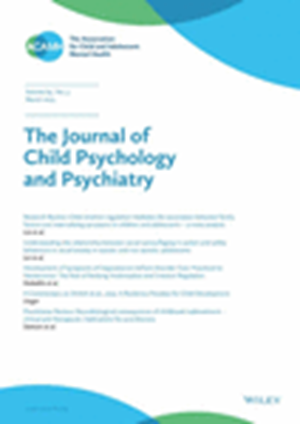轻度言语自闭症患者意外双语的早期表现。
IF 7
1区 医学
Q1 PSYCHIATRY
引用次数: 0
摘要
背景自闭症患者的预期双语(UB),即儿童会说在其社会环境中不使用的语言,已被零星报道。UB意味着自闭症儿童可以通过非社会互动的方式习得语言。自闭症患者早期语言能力最低的时期对于非互动语言习得至关重要,因为在那个时期非社会兴趣占主导地位。然而,这一时期社会互动之外的语言习得证据仍然有限,而且仅限于小案例研究。方法对119名自闭症儿童、102名非自闭症临床儿童和75名典型发育(TD)儿童的2-6岁儿童进行结构化的语言兴趣和使用问卷调查。他们还被要求估计他们的孩子在他们的社会环境中接触到的每种语言的相对比例。UB被操作为使用至少一种在儿童的社会环境中不使用的语言来命名字母和/或数字。结果在自闭症组中,53%的人被认为是最低限度的语言。共有38.7%的自闭症儿童表现出UB,自闭症儿童表现出UB的可能性是TD儿童的4.38倍(p < 0.001)。相比之下,非自闭症临床儿童与TD儿童没有显著差异。UB的存在与儿童的表达性语言水平无关。在控制了自闭症儿童在社会上接触非主流语言的比例后,自闭症儿童使用非主流语言(这里是英语)的可能性是自闭症儿童的8.28倍(p < 0.001)。非互动媒体是照料者报告的解释自闭症儿童存在UB的唯一来源。结论自闭症儿童,即使是语言能力最低的儿童,在语言发展的某些方面对社会环境的依赖程度也较低。非互动的语言习得途径可能在自闭症早期语言发展中起着重要作用。本文章由计算机程序翻译,如有差异,请以英文原文为准。
Early manifestations of unexpected bilingualism in minimally verbal autism.
BACKGROUND
Unexpected bilingualism (UB) in autism, in which children speak languages not spoken in their social environment, has been sporadically reported. UB implies that autistic children can acquire languages in a non-socially interactive way. The early minimally verbal period in autism could be critical for non-interactive language acquisition, given the predominance of non-social interests at that time. However, evidence of language acquisition outside social interaction during this period remains limited and restricted to small case studies.
METHODS
Caregivers of 119 autistic, 102 non-autistic clinical, and 75 typically developing (TD) children aged 2-6 years completed a structured questionnaire about their children's language-related interests and use. They were also asked to estimate the relative proportion of each language their children were exposed to in their social environment. UB was operationalized as the use of at least one language not spoken in the child's social environment to name letters and/or numbers.
RESULTS
Of the autistic group, 53% were considered minimally verbal. A total of 38.7% of autistic children displayed UB, with autistic children being 4.38 times more likely to show UB than TD children (p < .001). In contrast, the non-autistic clinical children did not differ significantly from TD children. The presence of UB was not associated with the children's expressive language level. Autistic children were 8.28 times more likely than TD children to use a non-dominant language (here English) (p < .001), after controlling for their proportion of social exposure to that language. Non-interactive media were the only sources caregivers reported to explain the presence of UB in autistic children.
CONCLUSIONS
Autistic children, even those who are minimally verbal, are less dependent on their social environment for specific aspects of language development. Non-interactive pathways of language acquisition may have a prominent role in early language development in autism.
求助全文
通过发布文献求助,成功后即可免费获取论文全文。
去求助
来源期刊
CiteScore
13.80
自引率
5.30%
发文量
169
审稿时长
1 months
期刊介绍:
The Journal of Child Psychology and Psychiatry (JCPP) is a highly regarded international publication that focuses on the fields of child and adolescent psychology and psychiatry. It is recognized for publishing top-tier, clinically relevant research across various disciplines related to these areas. JCPP has a broad global readership and covers a diverse range of topics, including:
Epidemiology: Studies on the prevalence and distribution of mental health issues in children and adolescents.
Diagnosis: Research on the identification and classification of childhood disorders.
Treatments: Psychotherapeutic and psychopharmacological interventions for child and adolescent mental health.
Behavior and Cognition: Studies on the behavioral and cognitive aspects of childhood disorders.
Neuroscience and Neurobiology: Research on the neural and biological underpinnings of child mental health.
Genetics: Genetic factors contributing to the development of childhood disorders.
JCPP serves as a platform for integrating empirical research, clinical studies, and high-quality reviews from diverse perspectives, theoretical viewpoints, and disciplines. This interdisciplinary approach is a key feature of the journal, as it fosters a comprehensive understanding of child and adolescent mental health.
The Journal of Child Psychology and Psychiatry is published 12 times a year and is affiliated with the Association for Child and Adolescent Mental Health (ACAMH), which supports the journal's mission to advance knowledge and practice in the field of child and adolescent mental health.

 求助内容:
求助内容: 应助结果提醒方式:
应助结果提醒方式:


